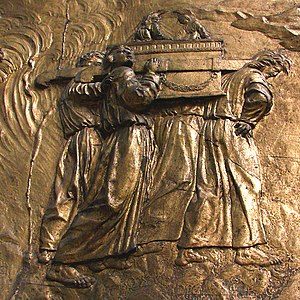I would guess that at least some long time visitors and friends for this site, as well as new visitors who look at some of the site's history, will notice that the theme was mostly Buddhist in nature and is less so over the past 12-18 months. At least overtly Buddhist, as in bearing the trappings of (East) Asian culture. There are still posts that are "Buddhist" even by this standard, but there has been much more on general spirituality and religion, interfaith issues, and Christian themes. Some of this is partially
explained by the background page I created.
As I alluded to there and elsewhere, I am not trying to "put a yak's head on a cow's body". I don't think Christianity are Buddhism are the same religion or that should be stitched together as one; they clearly have different perspectives, backgrounds, and methods. They come from different cultures and have developed around specific concerns. That does not mean that they cannot both reflect touching or learning from the same ground of wisdom, or that they aren't sisters. They can be unique and still have the same mother. In fact, we can see examples of how
they both approach similar concerns very differently, yet underneath may be lurking a common thread. In fact, it is the fact that they each diverge widely in some ways while retaining some key fundamental similarities that makes them more compatible to me. Rather than trying to cover the same ground, and hence being directly in conflict, there distinctiveness allows them to be complementary. This gives them quite a bit they can learn from each other, an interesting interconnection between East and West. In it much like the yin and yang combining in the classic Taoist symbol, as I am holding both traditions in a dynamic tension.
I have always found Buddhist sutras, poetry and prayers, particularly of the East Asian/Mahayana traditions, to be very inspiring and moving. The affirmation they offer, the consistently peaceful and empowering imagery and message, on occasion provokes a faint but endearing sense approaching what I imagine the sacred is like. But I sometimes get fatigued with some elements of Western Buddhism, which ever so lightly imply they or their tradition is
better than those "religious people" (there are those deny Buddhism is a religion because of the baggage they associate with that term), especially those from Western/Abrahamic religions. I admit to once being tempted to feel the same way, to feel
bodhier than thou. And while I may not look down on Christianity as a whole anymore, I am still tempted to be less than charitable towards those who have been loosely labeled fundamentalists.
On the other hand, I've been drawn to several traditions in East Asian Buddhism (Chinese Pure Land, Shin, Chan, Zen, Nichiren Buddhism, etc), and have had a hard time consistently following one or finding groups to meet with. That of course can be seen as providing an opportunity to create new inroads and build something, but it also means much less support for someone who needs it. There is also a kind of energy in Buddhism as it propagates out of Asia, a vitality and an enthusiasm that captures the imagination and the heart. Ironically, in places like Japan, Buddhism is said to be slowly turning into a funeral religion. That is, people turn to it for major occasions in life; since those who practice it tend to be older, the most common occasion is, of course, the end of life. This trend is also seen in the Christian equivalent of East Asia for Buddhism. i.e. Europe (and by extension the United States). Old school and mainline Christian denominations have been on the decline for decades. Yet newer incarnations that have their roots in the first half of the 20th century such as Pentecostalism are making waves in the old territories, much like groups such as the Soka Gakkai have in Japan. And these Christian movements also have quite the vitality as they spread into places like Latin America and Africa.









